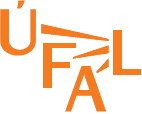Differences
This shows you the differences between two versions of the page.
| Both sides previous revision Previous revision Next revision | Previous revision | ||
|
courses:rg:predicting_human_brain_activity_associated_with_the_meanings_of_nouns [2011/09/11 12:20] ufal |
courses:rg:predicting_human_brain_activity_associated_with_the_meanings_of_nouns [2011/09/11 12:52] (current) ufal |
||
|---|---|---|---|
| Line 48: | Line 48: | ||
| ===== What do we like about the paper ===== | ===== What do we like about the paper ===== | ||
| + | * paper describes an interesting field of neurolinguistics and combines it in a very neat way with distributional methods of computational linguistics | ||
| + | * authors designed a lot of various smart experiments to prove the quality of their model. The results are promising. | ||
| ===== What do we dislike about the paper ===== | ===== What do we dislike about the paper ===== | ||
| * authors selected 25 sensory-motor verbs as a basis for their co-occurence features. But they did not sufficiently explain what led them to pick exactly these ones. | * authors selected 25 sensory-motor verbs as a basis for their co-occurence features. But they did not sufficiently explain what led them to pick exactly these ones. | ||
| - | * | + | * gold standard fMRI images are the result of word-picture pair being presented to participants. We think, that showing a picture on the one hand can be helpful for an individual to imagine the thing, on the other hand it can strictly limit the variety of concepts that an individual can assign to the word. It is similar to reading a book vs. watching a movie. |
| + | * for how long were the participants exposed to every word-picture pair? If it is too long, an individual can start to think about other things that he considers to be related with an original thing | ||
| + | * it would be interesting to carry out similar research on abstract words | ||
| Written by Michal Novák | Written by Michal Novák | ||
